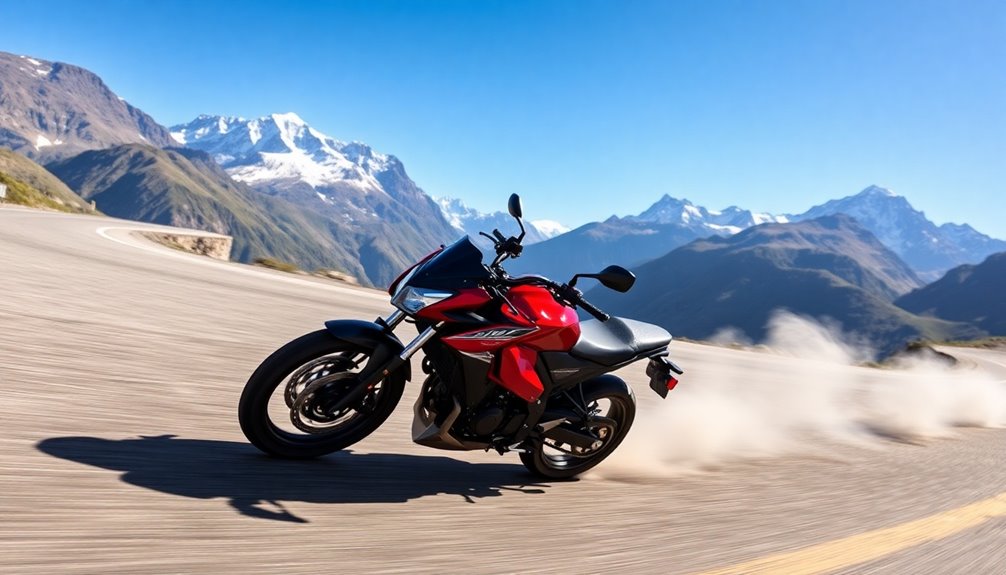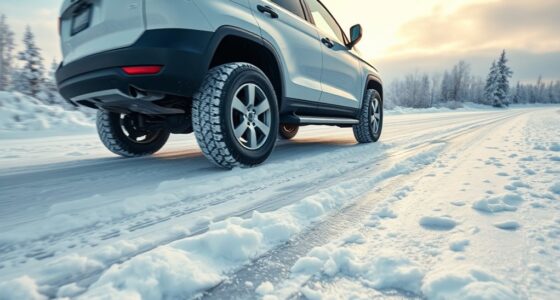Understanding rolling resistance in mud and clay involves recognizing how moisture, soil texture, and compaction affect how much effort it takes for your vehicle to move. Wet soils increase resistance due to cohesion, while loose or uneven terrains cause more drag. Tire design also plays a vital role; wider tires and proper inflation can help distribute weight and reduce resistance. Keep these factors in mind to improve traction and efficiency—exploring further will reveal how to optimize your approach.
Key Takeaways
- Moisture content increases soil cohesion and deformability, raising resistance during movement in mud and clay.
- Soil texture, such as stickiness or coarseness, directly impacts the grip and rolling resistance of tires.
- Proper tire design, including tread pattern and inflation, helps mitigate resistance in soft, wet terrains.
- Soil compaction and unevenness in mud and clay elevate the energy needed for vehicles to traverse these terrains.
- Measurement techniques like field testing and force sensors provide insights into resistance levels in muddy and clay soils.
Factors Influencing Resistance in Soft Soils

Soft soils present unique challenges when it comes to rolling resistance, primarily because their properties directly affect how easily wheels or tires can move across them. The moisture content, texture, and compaction level of mud or clay determine how much resistance you’ll face. High water content makes soils more deformable, increasing energy needed to push through or over the surface. Loose or poorly compacted soils create uneven terrain, causing additional drag and uneven wear. Sticky or cohesive soils tend to cling to tires, adding friction and reducing efficiency. As you drive or operate equipment, understanding these soil properties helps you anticipate resistance levels. Recognizing how moisture, texture, and compaction influence resistance allows you to adapt your approach, reducing energy consumption and improving performance on soft, challenging terrains. Additionally, soil cohesion impacts how much force is required to move through or over these surfaces, further affecting rolling resistance.
The Role of Tire and Wheel Design
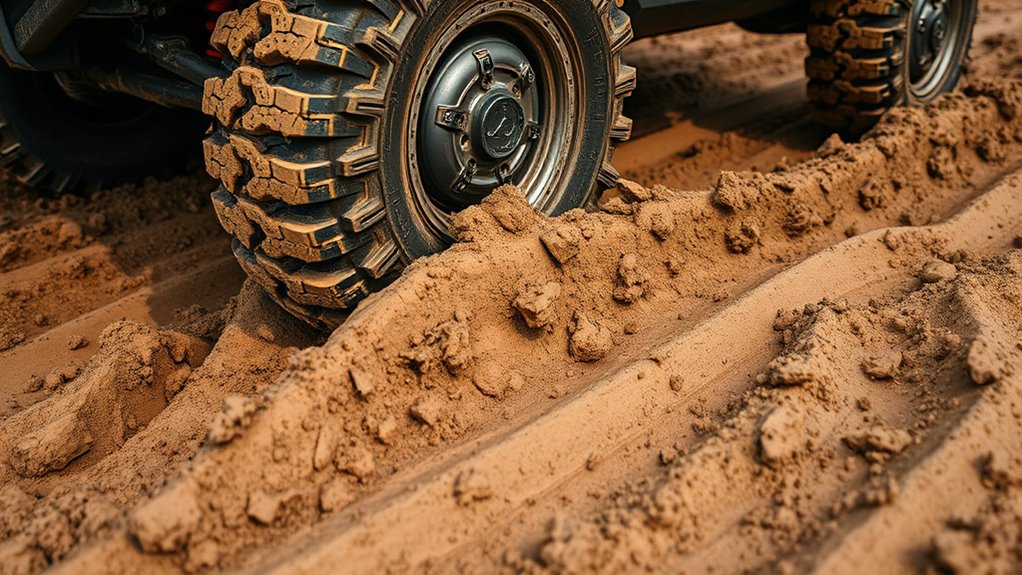
Tire and wheel design play a essential role in managing rolling resistance, especially on challenging terrains. When steering through mud and clay, wider tires distribute your vehicle’s weight more evenly, reducing ground pressure and minimizing soil disturbance. Tread patterns also matter; aggressive, deep treads provide better grip but can increase resistance, so balancing traction with smoothness is key. Wheel size influences rolling resistance too—larger wheels roll more easily over obstacles, decreasing resistance. Materials matter as well; lightweight alloys reduce overall mass, requiring less energy to move. Proper inflation is critical, too—over- or under-inflated tires can increase resistance and soil compaction. Additionally, choosing tires with optimal rolling resistance properties can significantly improve fuel efficiency and reduce tire wear. Ultimately, choosing the right tire and wheel design tailored to specific conditions helps you improve efficiency and traction on muddy and clayey surfaces.
Impact of Moisture Content and Soil Composition

Moisture content and soil composition markedly influence rolling resistance because they directly affect how a vehicle interacts with the ground. When the soil is moist, it tends to become softer and more cohesive, increasing resistance as tires sink and struggle to roll smoothly. Dry soil, especially loose sand or gravel, offers less grip but can still generate high resistance if it’s uneven or rough. Clay-rich soils are sticky when wet, creating a sticky surface that requires more force to move through. Soil composition, including particle size and organic content, also impacts resistance; fine particles like silt or clay increase adhesion, while coarse materials like gravel reduce it. Additionally, the soil structure and compaction levels can significantly alter how much resistance is encountered, affecting vehicle performance and fuel efficiency. Understanding these factors helps you anticipate how different terrains will affect vehicle performance and fuel efficiency.
Measurement Techniques for Rolling Resistance
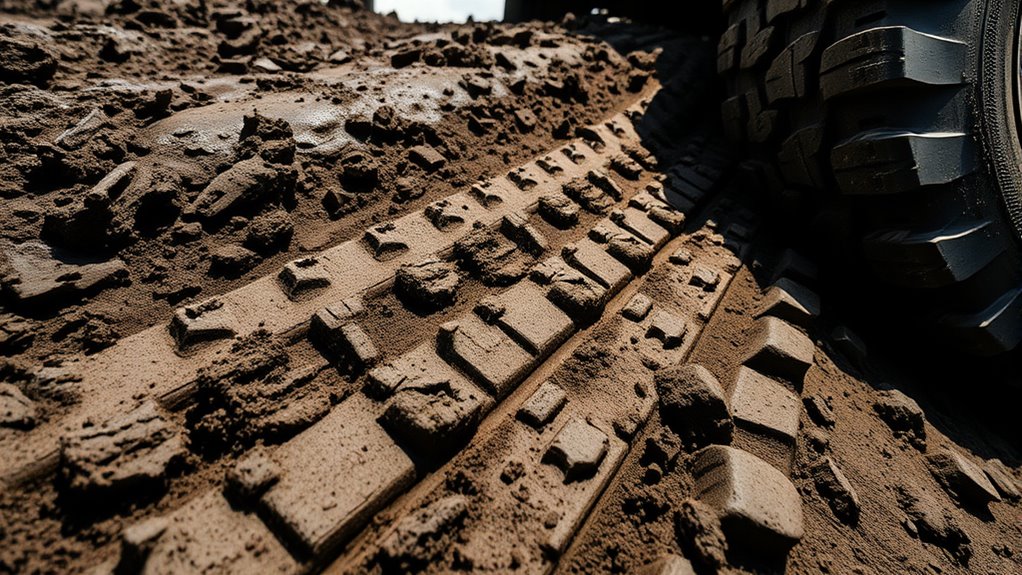
Measuring rolling resistance accurately is essential for understanding how different terrains and vehicle conditions impact fuel efficiency and performance. One common method involves using a specialized test rig where you load a tire or wheel onto a surface that mimics mud or clay. You then measure the force required to keep the wheel moving at a constant speed, often with a dynamometer or load cell. Another approach uses field testing, where you record the energy consumption or torque needed to drive a vehicle over a specific section of terrain. Data loggers and sensors capture real-time resistance forces, allowing for detailed analysis. Consistent measurement techniques ensure reliable comparisons between terrains, helping you develop better strategies for vehicle performance and fuel economy in challenging conditions. Incorporating advanced testing tools can further improve measurement accuracy and reliability.
Strategies to Minimize Resistance and Improve Traction
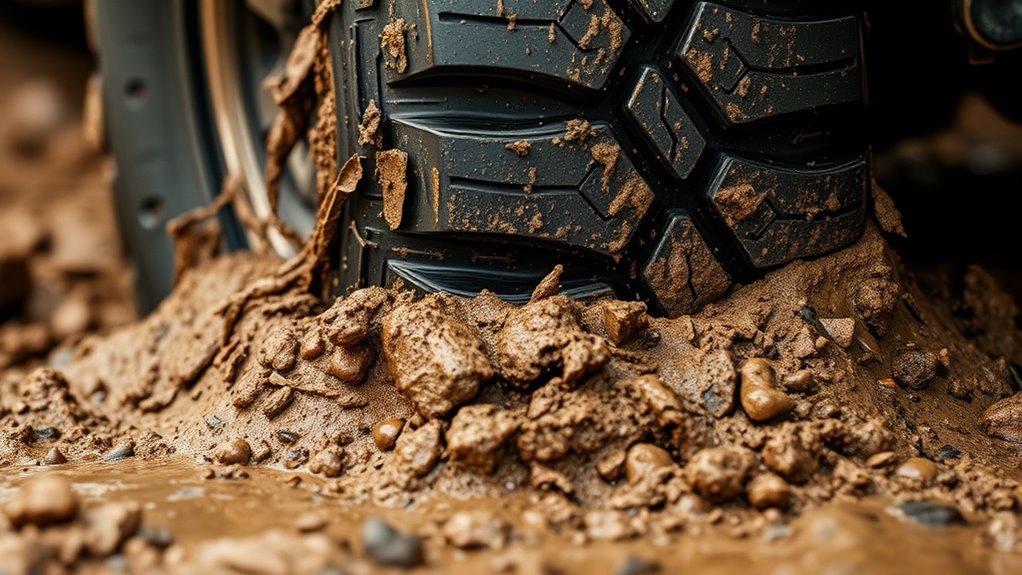
To minimize rolling resistance and enhance traction, you should focus on selecting appropriate tire types and optimizing their inflation pressures. Use tires designed for muddy and clay conditions, which feature deeper treads and reinforced sidewalls. Proper inflation is critical; under-inflated tires increase resistance, while over-inflation reduces grip. Adjust pressures based on terrain and load. Consider the following strategies:
| Strategy | Benefit | Implementation Tip |
|---|---|---|
| Use specialized tires | Better grip in mud and clay | Choose tires with deep treads |
| Maintain ideal pressure | Reduces resistance and slips | Regularly check and adjust pressure |
| Add weight strategically | Improves traction | Distribute weight evenly |
| Use tire chains or studs | Enhance grip | Apply in extremely soft conditions |
Additionally, understanding rolling resistance can help you select the most efficient tires for your needs.
Frequently Asked Questions
How Does Temperature Affect Rolling Resistance in Muddy Conditions?
Temperature directly impacts rolling resistance in muddy conditions. When it’s colder, the mud becomes firmer, reducing resistance and making it easier for tires to roll. Conversely, higher temperatures soften the mud, increasing its stickiness and resistance. You’ll find that in warm conditions, your vehicle faces more effort to move through the mud, so adjusting your driving or tire pressure can help manage the increased rolling resistance effectively.
Can Artificial Additives Reduce Soil Resistance for Vehicles?
You wonder if artificial additives can reduce soil resistance for vehicles. These additives, like surfactants or soil stabilizers, can alter soil properties, making it less resistant and more manageable. By breaking down soil cohesion or increasing permeability, they help vehicles move more easily. However, their effectiveness depends on soil type and conditions. Always consider environmental impacts and proper application methods before using such additives.
What Safety Precautions Are Needed During Resistance Testing?
Think of resistance testing as steering a stormy sea; safety is your sturdy vessel. You should wear appropriate protective gear, including gloves and eye protection, to guard against unexpected splashes or debris. Make certain the testing area is clear of bystanders, and use proper equipment with safety features. Always follow manufacturer instructions and emergency protocols, so you stay steady and secure while uncovering the secrets hidden beneath the surface.
How Do Different Vehicle Weights Influence Resistance in Soft Soils?
Different vehicle weights considerably influence resistance in soft soils. Heavier vehicles exert more pressure, causing the tires to sink deeper and increasing the rolling resistance. This makes it harder to move through mud and clay, as more energy is needed to overcome the soil’s deformation. To minimize this effect, you should consider distributing weight evenly, using appropriate tires, and reducing load when maneuvering soft terrains.
Are There Eco-Friendly Solutions to Lower Rolling Resistance in Mud?
Think of eco-friendly solutions as gentle raindrops easing your journey through mud. You can opt for lightweight, biodegradable tires that reduce pressure on the soft ground, or choose tires with low rolling resistance to minimize energy loss. Regularly maintaining tire pressure and using eco-conscious lubricants can also help. These choices act like a invigorating breeze, making your drive greener and easier, while lessening the impact on delicate soils.
Conclusion
Think of your tires as the feet of a traveler crossing muddy terrain. Each step you take is influenced by the soil’s mood—its moisture and texture—just like a dance partner’s grip. By understanding and adapting your approach, you can glide smoothly, like a boat steering through calm waters. Remember, mastering rolling resistance is about harmonizing with the environment, turning challenges into opportunities, and moving forward with confidence on every muddy journey you face.


